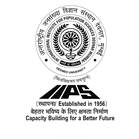- About IIPS
- Academics
- Study @ IIPS
- Departments
- Centres
- Controller of Examination
- Programme
- Distance and Online Education
- Training
- Facilities/Services
- Resources
- Virtual Learning
- Digital Initiatives (MHRD)
- Notice
- Seminars / Workshops / Conferences
- Conferences
- Publications
- Seminars
- Sponsored Research
- Workshops
- Collaboration
- National
- International
- NEP 2020
- Admission
- Courses
- Admission Bulletin
- TIME-TABLE For Admission 2025-26
- Model Question Papers
- Programme Coordinators
- Fellowships
- Academic Calendar
- International Students
- Visa Information
- Administration
- Faculty & Staff
- Research & Publications
- Library
- Information
- Right to Information
- Vigilance Officer
- Annual Report
- Director's Report
- Cells & Commitees
- Cells
- Commitees
- Committees of NEP 2020
- Staff Walfare Committee
- Cultural Committee
- Internal Committee
- Purchase Commitee
- Students Academic Committee
- Student Research Ethics Committee
- Anti-Ragging Committee
- Institutional Review Board
- Social Media Committee
- Prevention of Caste-based Discrimination Committee
- Code of Conduct and Professional Ethics
- National and International honours, Awards, Recognition, and Medals
- Online Facilities
- Employee's Corner
- Memorial Lectures
- Convocation
- IIPS Newsletters
- COVID 19 Information
- Life @ IIPS
Department of Fertility & Social Demography
- Home
- Academics
- Departments
- Department of Fertility & Social Demography
Fertility is one of the three core domains of Demography. Fertility trends and future prospects are integral components of economic and social planning, labour supply, and development process. The Department of Fertility Studies was established when the University was granted the status of a Deemed to be University. The department faculty members actively engage in teaching, undertaking research, and guiding students in the area of fertility and its measurements, nuptiality, contraception, and human reproduction. The department encourages a comprehensive multidimensional approach in teaching and research in human fertility and fertility transition. The department focuses on important thrust areas in theoretical and empirical research, which can be helpful in the further development of fertility theories and policymaking. These areas include biosocial, behavioural, and proximate determinants of fertility; abortion, low/high fertility and infertility and their implications; socioeconomic and spatial patterns in fertility transition; fertility and development nexus; reproductive rights; women’s empowerment and fertility; marriage rate; age at the time of marriage and its correlations; marriage markets and squeeze; sex preference and its effects on fertility and sex ratio at birth; and historical aspects of human fertility. Furthermore, the department ensures that research conducted in human fertility must address local, national, and global issues. The faculty members and researchers at the department possess expertise in the analysis of birth histories and advanced statistical modelling by using the datasets from the large-scale surveys, such as Demographic Health Surveys, District-Level Household and Facility Survey, India Human Development Survey, and Censuses. The department has proficiency in conducting qualitative studies to examine the complex socio-cultural and behavioural aspects of fertility change. Faculty members and researchers at the department have published research papers in peer reviewed journals and conducted several collaborative studies with national and foreign researchers in the aforementioned thrust areas.
